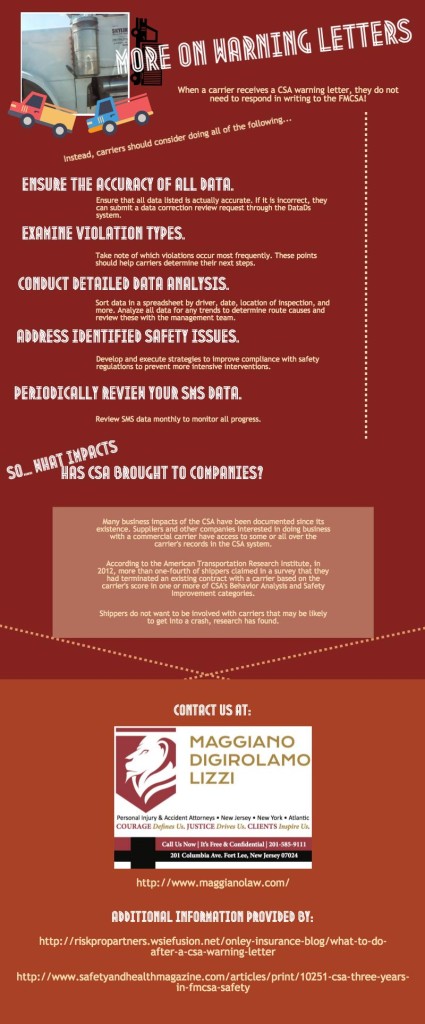What is CSA, and How Does it Affect Me?
 To understand CSA, first you will need to know what it stands for – Compliance, Safety, and Accountability. The Federal Motor Carrier Safety Administration (FMCSA) directs the program, which is in charge of holding motor carriers accountable for their role in safety. What exactly does the CSA do, you may be wondering?
To understand CSA, first you will need to know what it stands for – Compliance, Safety, and Accountability. The Federal Motor Carrier Safety Administration (FMCSA) directs the program, which is in charge of holding motor carriers accountable for their role in safety. What exactly does the CSA do, you may be wondering?
- Affects motor carriers, including owner-operators, by identifying the ones with safety problems
- Prioritizes motor carriers for interventions like warning letters and investigations
- Urges drivers to stay involved with their safety performance and compliance, which will impact their safety records (1)
Warning Letters and Investigations
Investigators working for the CSA are equipped to evaluate why safety problems occur and recommend remedies to solve these issues. When corrective actions aren’t followed, this is where penalties come into play. Interventions like warning letters and investigations provide carriers with necessary information that can help them understand their safety problems and change unsafe behavior from the get-go. Now you can grasp a better understanding of warning letters and investigations, and how they work.
- Warning Letters: These letters are sent to a carrier’s place of business to specifically identify a Behavior Analysis and Safety Improvement Category (BASIC). They also outline the possible consequences of continued safety problems and provide instructions for accessing carrier safety data and measurement.
- Investigation: These include offsite investigations that require a carrier to submit documents to FMCSA or a State Partner and are used to evaluate the safety problems that are identified through the SMS. They also include onsite-focused investigations, which include maintenance records and so-forth. Onsite Comprehensive Investigations take place at a carrier’s place of business and are used when the carrier exhibits many safety problems. (2)
The Safety Measurement System
So, what is the Safety Measurement System (SMS)? This is where your company’s safety data appears online. The FMCSA updates this data once a month with roadside inspection information, driver and vehicle violations, crash reports from the past two years, and investigation results. They consider the number of safety violations and inspections, the severity of these safety violations and crashes, when the safety violations occurred, and the number of trucks/buses that a carrier operates.
This SMS data is organized into seven BASICs, which include Unsafe Driving, Crash Indicator, Hours-of-Service Compliance, Vehicle Maintenance, Controlled Substances/Alcohol, Hazardous Materials Compliance, and Driver Fitness. (1)
There is also a point system for BASICs. The severity weight “points” range from 1 to 10, with the least serious violations rated with a 1 and points more severe getting closer to 10. Measurement for these points depend upon the number of violations that there were, the severity of these violations, and how long ago they happened. These points can affect the employer’s rating because they become a part of the carrier’s safety rating for 36 months, and can affect being hired by future employers. It can also affect a driver’s SMS record, which could lead to more consequences like being issued a NOV (Notice of Violation) or a NOC (Notice of Claim). (3)
So, why is CSA so important? It is a fact that approximately five million truck and bus drivers share the road with more than 250 million motorists. These are very high stakes and no driver wants to be at risk on the roadways. This is where the CSA comes into play with their helpful information and safety tips. Always stay informed, check your company’s safety records, order driver records, request data reviews through DataQs, and find information on ways to improve your safety performance and compliance. In the end, everybody wins!
(1) https://csa.fmcsa.dot.gov/Documents/What_is_CSA_Factsheet_GRS_P_Final_508.pdf
(2) https://csa.fmcsa.dot.gov/about/interventions.aspx
(3) http://www.whatiscsa.com/driver/

















